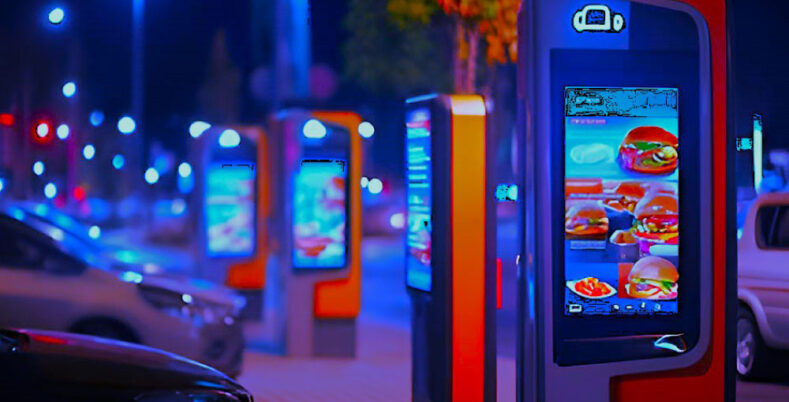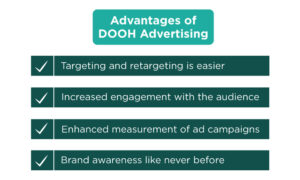Digital out-of-home media has revolutionized orthodox outdoor advertising methods!
While on the roads, you must have experienced engaging billboards stealing your attention! They are nothing but a form of Out-of-home (OOH) advertising. The method went through further tech transformations and contributed to the evolution of digital out-of-home, or DOOH advertising.
Many of us do not really know what digital out-of-home ads are, yet the global industry valuation it holds is $27.5 billion in 2024. So, who is using such strategies, and for whom? Marketers and industry leaders across the globe implement such tactics to engage with their audiences more impactfully.
DOOH ads are contemporarily placed both outdoors and indoors in stores. Let us understand the potential of digital out-of-home advertising alongside its progression over the years.
Defining DOOH Advertising:
Digital out-of-home ads are publicly displayed media which typically appear outdoors. It includes tech-enabled, creative, and dynamic displays to attract the audience. In a way, DOOH ads amalgamate traditional and advanced advertising techniques to get the most impactful results.
DOOH ads are a data-driven approach that allows brands to engage in a unique way with their audience, assessing large amounts of real-time user data. It is an elementary technique to create a buzz about a product or service among a large audience. Though DOOH ads include digital elements, their traffic generation parameter is way different than that of internet media.
Since such ads are targeted at a larger audience, there are minimal opportunities for personalization. However, creativity and visual attraction are compulsory components while attracting an audience with a diverse mindset. Busy areas with high traffic are usual spots for DOOH ads. One of the significant specimens of DOOH advertising is digital billboards.
Decoding Different Formats of DOOH Ads:
There are three broad formats of DOOH media, including:
Large Billboards:
Larger forms of DOOH media are chiefly the roadside billboards that people are generally on the move. These are typically placed near highways, city buildings, or vehicle stations where a bigger audience regularly walks or drives through. This format offers a greater impact when it comes to boosting brand or product awareness.
Location-centric Ads:
It is a more targeted form of DOOH media that is specifically displayed to a set of audiences who might have an interest in spending on certain products. For example, displaying healthcare products in the hallway of a hospital. The model offers the opportunity to customize the advertisements as per the specifications of viewers.
Point-of-purchase Ads:
The model of point-of-sale ads promotes products to people who are already buyers. Suppose you are buying goods in a grocery store; the DOOH ads will be placed near the payment counter or the checkout desk. Such media often appear in grocery stores, gas stations, shopping malls, and others. It is a core way to increase brand visibility.
The Emergence of Digital Out-of-Home Advertising:
DOOH advertising is nothing but an outcome of the ever-evolving advertising and marketing sectors. In today’s competitive world, it has emerged as a powerful tool to boost brand awareness and overall business advancement. While evaluating the rise of DOOH media, it is necessary to trace the progression of out-of-home ads, which has been an influential strategy for ages.
Primarily, OOH ads appeared as general indications and posters to guide people. Nevertheless, the practice took the form of billboards in no time and became a channel of impactful advertising. The challenge afterward raised was measurement and accountability. Marketers implemented OOH ads and sustained growth but were unable to measure its exact ROI. Soon, with digital adaptation, OOH media received a new identity that we know today as digital out-of-home advertisements.
DOOH ads, being a data-driven approach, offered high measurability opportunities. Advertisers used real-time data to design the billboards, leaving various data points such as sensors, mobile location, surveys, foot traffic, and others to collect insights while measuring the impact and returns on investment (ROI). Following such possibilities, DOOH media became remarkably popular in the commercial and non-commercial sectors.
Observing the significant progression and impact, alongside businesses, the governments of various nations also used the method to dissminate their messages to the common public.
Exploring the possibilities — Advantages of DOOH Advertising
Targeting and retargeting is easier:
DOOH media allows businesses to target and retarget their audience. With programmatic abilities, the ads are displayed to the most convenient set of people at the most convenient time. Such quality contributes to sustained brand awareness among a larger audience.
Increased engagement with the audience:
Brands usually integrate DOOH advertising to engage with their audience more effectively. With creative ideas and visuals, such ads attract the audience and impart the message that they carry skillfully, amplifying engagement remarkably.
Enhanced measurement of ad campaigns:
DOOH eliminates the challenge of the inability to measure ad campaign performance. With several location-based technologies and sensors, the model collects user data post-engagement, which enables brands to easily measure the outcome of a campaign.
Brand awareness like never before:
DOOH ads are very effective in boosting brand awareness and visibility in the industry. The model promotes brands and their products publicly instead of following an individual approach. It contributes to enhancing brand awareness alongside bringing a sense of credibility.
What is Programmatic DOOH Advertising?
Programmatic DOOH, or pDOOH, is a subset of digital out-of-home ads that utilizes advanced data analytics and algorithms to measure the engagement and impact of digital screens that are placed for advertising purposes. The process further incorporates automation while buying and selling positions for DOOH ads.
With characteristics like social media mirroring, pDOOH has gained immense popularity lately. Increased targeting, quick installation, real-time optimization, flexibility, and effective measurement are the top benefits of programmatic DOOH.
What the Future Holds!
As DOOH advertising continues to expand rapidly, its future looks increasingly promising. The advertising model not only benefits retailers but can also support tech companies and other service providers in growing. It chiefly focuses on enhancing brand awareness, which is a key aspect of successful businesses. Moreover, with programmatic abilities, DOOH ads have become more measurable, through which businesses can quantify the performance of their ad campaigns.
Learn more about the latest technologies and trends with KnowledgeNile!
Frequently Asked Questions:
Q: What does dooh mean in advertising?
Digital out-of-home or DOOH advertising is a tech and data-driven advertising model. Such ads are generally placed outdoors; however, recently, they have been integrated indoors as well and are typically placed in grocery stores and shopping malls. One of the examples of DOOH media is digital billboards.
Q: What is Fooh advertising?
Fake out-of-home or FOOH advertising denotes the process of advertising integrating virtual reality or immersive elements. The model involves CGI to create a fake environment that seems real to people. FOOH ads are an innovative version of OOH media that captivates audiences very quickly.
Recommended For You:
Artificial Intelligence in Advertising: Examples & Applications






